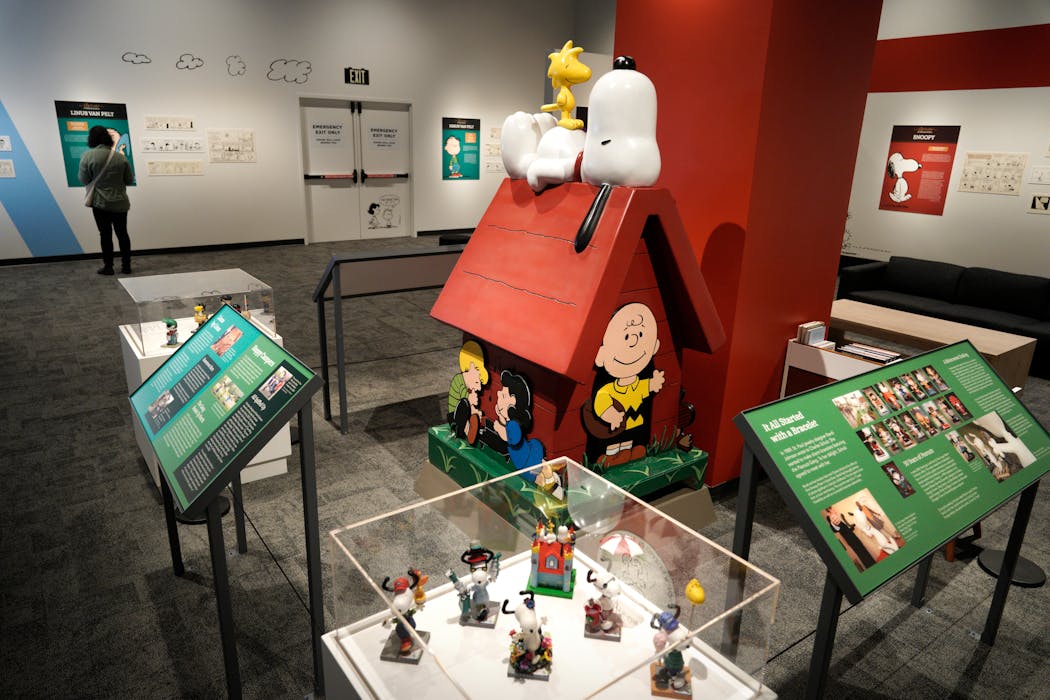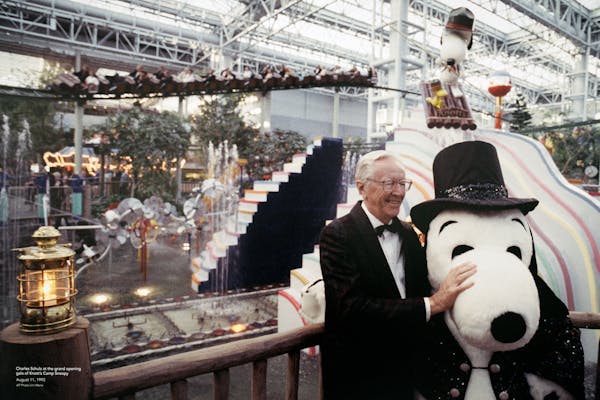Kate Glavan is into that dog.
So much so that she wears an inflatable Snoopy costume and films herself dancing on the roof of her apartment building.
Glavan, who grew up in Edina and is now a digital creator in New York City, often shares her love of Charles Schulz's daydreaming beagle on Instagram and TikTok.
"Snoopy is such a comfort character," the 25-year-old said.
Glavan's obsession with Snoopy was fueled by the "Peanuts" television specials she watched growing up, visits to the Mall of America's Camp Snoopy (now Nickelodeon Universe) and photos snapped next to the many "Peanuts" statues scattered around the Twin Cities that celebrate the characters' creator, a Twin Cities native.
But it's not just a Minnesota thing. Around the country, Gen Z has apparently fallen hard for the 1950 beagle.
This holiday season, those born just too late for the Tickle Me Elmo craze led a run on a puffer-clad plush Snoopy exclusive to CVS. (As with Elmo, Snoopy doll-hunters were staking out stores, and resellers demanded many times the toy's original price.) Last April, a Red Cross Snoopy-as-Joe Cool T-shirt giveaway went viral and drew throngs of young blood donors.
The internet is awash in Snoopy memes, and social media accounts devoted to the dog are followed by hundreds of thousands. Like so many other vintage, kid-oriented characters, Snoopy's mug is on every type of merch.
"Every time I see Snoopy memorabilia now, I feel a sense of nostalgia," Glavan said. "I own a few T-shirts, plush dolls, an Advent calendar, backpack, and a few posters."
But the pup's popularity wouldn't cut across generations if it were just about cuteness.
For older members of Gen Z, Snoopy's appeal may relate to longing for the carefree childhood they've recently traded for adult responsibilities. For them, that was era when abundant free time could be squandered on comics and cartoons and when watching the giant balloon beagle float past during Macy's Thanksgiving Day Parade was a must. And it was long before a college course on "Peanuts" (yes, really) was offered: It requires students to "examine and discuss the strip in aesthetic, narrative, and interdisciplinary contexts."
The sense of belonging created by this shared cultural touchstone also burnishes Snoopy's popularity with teenagers and young adults. As Glavan described her puffer-wearing pup purchase to the Wall Street Journal: "It's one of those times when you can say, 'I was there, I went out and got this doll while it was happening,'" she said. "It's a symbol that you were online when the Snoopy renaissance was happening."
But personality traits specific to Snoopy also seem to speak Gen Z's language — and speak to its collective mood.
Snoopy's unabashed expressiveness fits the digital natives' preference for terse, visually driven communication. His physical display of emotions — the overjoyed, nose-in-the-air dance; the lying, depressed, flat on his back atop his doghouse; the sunglasses-wearing nonchalance — are like a dog version of the emoji face.
And a generation that grew up using the internet to try on multiple personas can relate to the anthropomorphic pet's transforming himself into a WWI flying ace, tennis champ or wilderness explorer.
St. Paulite Bridget Lensing, 25, attributes the cartoon beagle's popularity with her generation to his ability to be so fully himself — leaning into his myriad alter egos, from Joe Cool to a World Famous Author.
Lensing, a longtime Snoopy lover, has been discussing her muse more often since she got him (in puffy coat) tattooed on her arm this fall, garnering many compliments.
"I love him," she said. "It's such a big part of people's childhoods for anyone in the Midwest," she said.
Uniting generations Last week, students on winter break flocked to "The Life and Art of Charles M. Schulz" exhibit at the Minnesota History Center in St. Paul accompanied by parents and grandparents.
Twentysomethings admiring the Schulz sketches and Lucy PEZ dispensers said they associated the cartoon characters with family bonding and childhoods when relatives passed along newspaper comics, gifted "Peanuts" anthologies, sang songs from the musical and watched "A Charlie Brown Christmas" together.
At one of the light tables, as Addy Adams, 20, traced a Snoopy drawing and said she likes how the character is so simple and constant, yet has multiple personas. Growing up as an only child, she identified with the way Snoopy used his imaginative "side quests" to entertain himself. "He just seemed like such a fun little guy caught up his own world," she said.
Adams, who works at the University of Minnesota's radio station, said she and her student colleagues (including one who goes by DJ Woodstock) share such a love of "Peanuts" that their graphic designer recently drew a staff portrait in the style of the characters.
While Gen Z may be driving Snoopy's resurgence, older generations are also trying to pinpoint what the "Peanuts" gang has meant to them and to our culture. That was the intent of the book "The Peanuts Papers": It is an essay collection by writers and cartoonists including Umberto Eco and Maxine Hong Kingston.
One of the authors whose work appears in the book, Kevin Powell, says he grew up in poverty and had a poster of Snoopy (which he still has) that helped him cope with depression. As an adult, he says he returns to Snoopy and the gang for inspiration "whenever I do not have the words myself to express a feeling, any feeling."
Novelist Ann Patchett's essay focuses on Snoopy. (Her own dog shares Schulz's nickname of Sparky.) Patchett describes reading "Peanuts" at her grandparents' house and learning — from Snoopy typing away atop his doghouse — what it was to be a writer. "Wait, am I seriously discussing Snoopy, a cartoon dog, as a writer? Am I believing in him as he was drawn to believe in himself?" Patchett asks. "I am. I did. I do."
Books Editor Chris Hewitt contributed to this story.

The 5 best things our food writers ate this week

A Minnesota field guide to snow shovels: Which one's best?

Summer Camp Guide: Find your best ones here

Lowertown St. Paul losing another restaurant as Dark Horse announces closing






